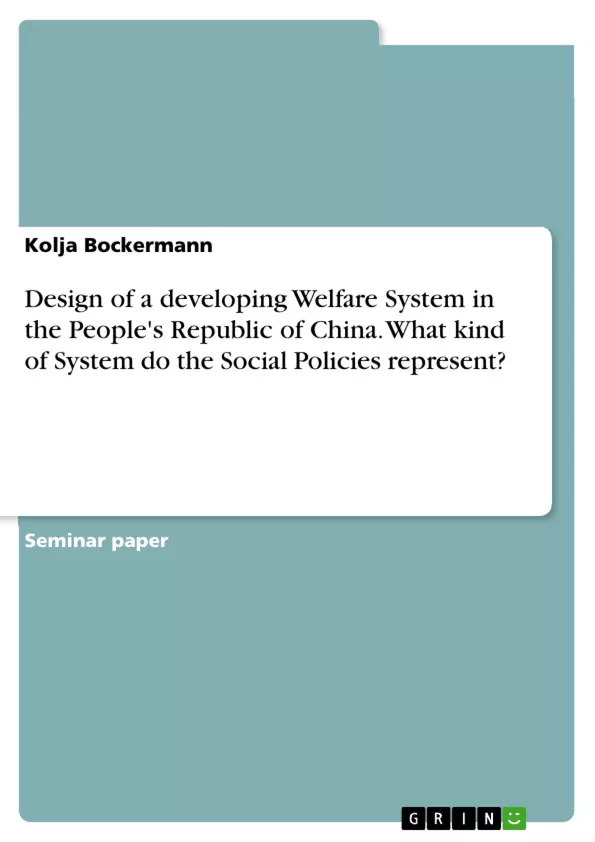This work discusses the Welfare System of the People's Republic of China. Chinas economy rose in the 1990 and developed into the worlds largest producer of goods. Furthermore it became increasingly influential in world politics so China started to join the family of countries which have a reasonable and widely available comprehensive System of social protection and welfare. They managed to grand their citizen the ability to prosper and providing basic needs, as well as fundamental social support. In 2010, the National Peoples Congress adopted the first national Social Insurance Law, representing the Culmination of a process of radical social reform and fundamental change in the sphere of Governmental Activities. To Represent the different Goals and Policies of the Welfare System being build in China it is important to understand what kind of welfare regime is being build in the Peoples Republic of China.
China has been a politically unique Country over the last 75 Years. It is one of only five remaining communist states in the world, besides Laos, Cuba, the Democratic Republic of Korea and Vietnam and besides some notable economical achievements from Vietnam, China is the only Communist State which had been economically Successful.
The Characteristics of a Communist State include centralized Power in the hands of a party elite which is presumably motivated, to act in varying degrees by some kind of socialist ideology of statism and social justice.
While the Peoples Republic of China has maintained its political uniqueness, the economic uniqueness of China shed over the last centuries. Mostly because China turned its back on isolationism and adopted due to Reform and Opening Up in the late 1970 and an open socialist market economy, this was enabled by following the Ideology of Deng Xiaopings „Reformation and Modernization“ Polices commonly know as Ideology in Chinese Politics, this Phase still has not Ended regarding to the Communist Party of the Peoples Republic of China Ideology.
Inhaltsverzeichnis (Table of Contents)
- Introduction
- The Development of the Chinese Welfare State
- Theoretical Approach - Definition of „Welfare\" State
- The Current Chinese Welfare System
- Conclusion
- Bibliography
- Legal Text and Provisions
- Web Sources
Zielsetzung und Themenschwerpunkte (Objectives and Key Themes)
This text explores the evolution of the Chinese welfare state, analyzing its development from its socialist roots to its current form. It examines the historical context of the welfare system in China, specifically considering the role of economic and political forces in its development. The text aims to understand whether China has replicated a conventional welfare state or developed a unique model shaped by its historical and political structure.
- The impact of economic and political forces on the development of the Chinese welfare state
- The role of historical context in shaping the Chinese welfare model
- The transition from a socialist system to a market economy and its consequences for social protection
- The development of social insurance schemes and their impact on different social groups
- The challenges of social inequality and poverty in the context of economic growth
Zusammenfassung der Kapitel (Chapter Summaries)
The introduction provides an overview of China's economic rise and its transition towards a comprehensive social welfare system. It highlights the significance of understanding the welfare regime being built in China and the unique characteristics of the country's political and economic landscape. The chapter discusses the theoretical approaches to explain welfare state developments, contrasting the "economic hypothesis" with the "political hypothesis" and highlighting the specific application of these theories in the Chinese context. The chapter on "The Development of the Chinese Welfare State" delves into the historical evolution of social policies and initiatives in China, starting with the formation of the People's Republic in 1949. It examines the "danwei" system, which provided comprehensive welfare packages for workers, and its subsequent dismantling in the wake of economic reforms. The chapter discusses the challenges posed by the dismantling of the "danwei" system, including social unrest and widespread poverty, and the subsequent emergence of a new welfare system in the 1990s.
Schlüsselwörter (Keywords)
The text focuses on the Chinese welfare state, its historical development, and its unique characteristics. Key terms and concepts include "welfare state," "social insurance," "danwei," "economic hypothesis," "political hypothesis," "social reforms," "socialist market economy," "social unrest," "poverty," and "inequality." The text also delves into specific social policies and initiatives implemented in China, such as the "Seventh Five Year Plan," the "Seven-Year Priority Poverty Alleviation Programm," and the "building a harmonious society" and "putting people first" slogans.
- Quote paper
- Kolja Bockermann (Author), 2020, Design of a developing Welfare System in the People's Republic of China. What kind of System do the Social Policies represent?, Munich, GRIN Verlag, https://www.grin.com/document/945556



